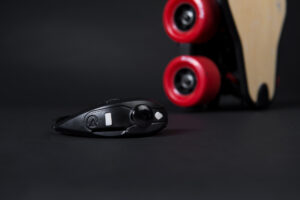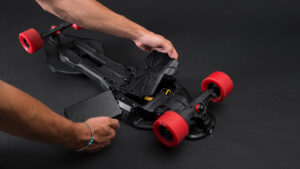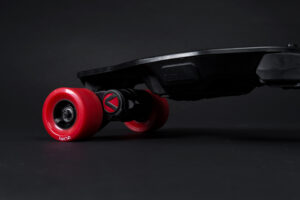An electric skateboard motor uses electromagnets to create rotation and movement. The motor has two main parts – the stationary stator and the rotor, which spins. The stator has coiled electromagnets powered by the battery. The rotor has magnets attached to the central shaft. So, in short, the motor uses magnetic forces to convert electricity into rotational motion. This innovative use of magnets allows electric skateboards to drive themselves without pushing!
Stator and Rotor – The Heart of the Motor
The heart of the electric skateboard motor is the stator and rotor. The stator consists of stacked electromagnetic coils surrounding a central cavity. When electricity from the battery enters the engine, it energizes these coils to become electromagnets.
Inside the stator’s cavity spins the rotor, a series of electromagnetic coils. The rotor is mounted on a shaft that exits the motor to transfer power to the wheels.
The key to generating continuous rotation is the interacting magnetic fields between the stationary stator and the rotating rotor. As alternating current alternates the polarity of the stator electromagnets, it creates a pushing and pulling effect on the rotor magnets, causing the rotor to spin in a fixed direction.
What are Brushless DC Motors
Brushless motors are more efficient than traditional brushed motors, which use a brushless motor to power its wheels, allowing for greater control over the speed and direction of the skateboard.
Many electric skateboards now use brushless motors, becoming increasingly popular due to their many benefits.

A brushless motor eboard requires battery power, a controller, and a motor as its main part. A battery powers the motor, and the board is controlled by remote control or by a rider’s weight shifts.
With the brushed motor, rotation is achieved by controlling the magnetic fields generated by the coils on the rotor, while the magnetic field generated by the stationary magnets remains fixed. To change the rotation speed, you change the voltage for the coils. With a BLDC motor, it is the permanent magnet that rotates; rotation is achieved by changing the direction of the magnetic fields generated by the surrounding stationary coils. To control the rotation, you adjust the magnitude and direction of the current into these coils.
BLDC motors offer high durability and low electric noise generation, thanks to the lack of brushes. With brushed motors, the brushes and commutator wear down as a result of continuous moving contact and also produce sparks where contact is made. Electrical noise, in particular, is the result of the strong sparks that tend to occur at the areas where the brushes pass over the gaps in the commutator. This is why BLDC motors are often considered preferable in applications where it is important to avoid electrical noise.
How To Choose A Electric Skateboard Motor: hub – direct drive –belt drive
Regular electric skateboard users are probably tilted to a section of the divide and would stick out their necks for a particular type of electric motor or drive. However, if you are yet to take sides on what the best motors for skateboards are, we will clarify for you.
Hub drive motor
Hub motors can be found everywhere. There is no gainsaying that hub motors are a darling to the skate community because of their relatively less expensive parts and their clean and simple implementation. They are quiet, stealthy, and consequently, appeal to most people.
That said, they do not come without cons of their own. They have a poor shock absorption system making for reduced comfort during a ride. They also do not have as much braking or torque power at the same power input levels.
Added to that, Hub drive board types in general usually experience a higher failure rate than their belt drive counterparts.
Direct drive motor
The direct drive train is one a lot of individuals are looking to jump on, however, there still exists a lot of misconceptions about what they are. Direct drives are systems where a full motor directly drives a full wheel.
In the past, hub drive and belt drive motors have all been marketed as direct drives, but they are quite a distance from how direct drives operate or what they are in essence.
Though the direct drive might seem like the dream electric skateboard motor and the best of the other two discussed above, it does have its disadvantages too. In a direct drive system, the motor isn’t shielded and sits right next to the wheel. Because its motor isn’t shielded, the ground clearance is affected, and the motor is most likely to be severely battered on bad roads.
In general, the direct drive is still a new and unproven technology and cannot be recommended for use based on that premise. Added to it is that there are suspicions of a reduction in torque when used.
Belt Drive Motor
Belt Drive motors are the most traditional drivetrain. They utilize an externally mounted motor with a gear-like pulley and belt to create a gear reduction on the motor before transferring power to the wheels as opposed to hub motors with the center of their wheels replaced by a motor.
While most loyalists of the belt drives would use nothing other than what they are used to, neutral minds have a few concerns about them, one of which is the noise they produce. They also need regular maintenance and have limited free-rolling ability.
Since the belt drives motor harbors a significant amount of resistance in its system – which makes it harder to kick-push – owing to the presence of pulleys, it is easy to see why they limit free rolling.
For skateboard users who aren’t mechanically inclined or have a thing for machines and how they operate, maintenance such as belt change due to wear and tear belt alignment and belt-tensioning could be a tough nut to crack
While redesigning the new Linky 2.0 we took into consideration the possibility of changing the motor system into a hub motor. But we chose to go again with a Belt drive, for the following reasons:
- Belt drives deliver better torque than hub drive motors even for the same price.
- They also give room for full longboard wheels as opposed to thin PU sleeves in Hub motors. This, in turn, allows for a wider selection of wheels to swap and choose from.
- Belt drives are lighter than hub drive motors.
Can we use an electric skateboard as a regular skateboard if we remove the motor from it?
Yes, it is possible to use an electric skateboard as a regular skateboard if you remove the motor from it. The main difference between electric and regular skateboards is the addition of an electric motor and battery that provide propulsion. By removing these components, the electric skateboard essentially becomes a regular skateboard.
However, there are a few things to keep in mind. First, electric skateboards often have larger wheels and a wider deck to accommodate the motor and battery. As a result, the skateboard may feel different when riding without these components. Second, the weight distribution of the skateboard may also be different without the motor and battery, which could affect the way it handles and turns.
Overall, while it is possible to use an electric skateboard as a regular skateboard after removing the motor and battery, it may feel different and require some adjustment. Additionally, it’s important to ensure that the skateboard is structurally sound and safe to ride before removing any components.
Additional Motor Features
Electric skateboard motors incorporate several other engineering elements to optimize functionality:
- Gearing ratios – Higher ratios prioritize torque over speed and vice versa.
- Sensored vs. sensorless – Sensored motors use sensors for precision position tracking to enhance low-speed control.
- Regenerative braking – Motors can charge the battery by harnessing energy while braking.
These features allow fine-tuning the motor’s power delivery and braking for specific riding purposes.
Electric skateboard motors represent an innovative use of electromagnetic principles to power a new era of compact transportation.
By coordinating the interaction of stator and rotor magnets, these motors can propel riders at up to 25mph.
Key components like the speed controller and precise motor placement enable performance tuning and handling improvements. While deceivingly simple on the outside, electric skateboard motors utilize advanced inner engineering to drive the wheels of these game-changing boards.
Understanding the inner workings of these motors opens up possibilities for further innovation and refinement. Enjoy the ride 🙂




